Are you struggling to manage customer calls efficiently? Maybe you’re overwhelmed by the number of options for call center software out there.
At WPBeginner, we’ve faced these same challenges for our business projects. We know how crucial it is to find a solution that fits your business needs without breaking the bank.
Over the years, we’ve learned that the right call center software can make a huge difference in how you connect with customers. It’s not just about answering calls – it’s about providing a seamless experience across all channels.
In this guide, we’ll cut through the noise and share our top picks for call center software in 2024.
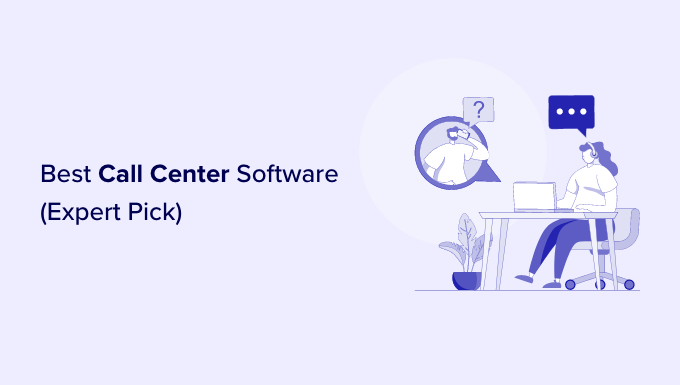
Top Call Center Software: An Overview
| Name | Starting price | Key features | |
|---|---|---|---|
| 🥇 | Nextiva | $30/mo | Cloud-based and multichannel support |
| 🥈 | RingCentral | $20/user/mo | Omnichannel support and gamification |
| 🥉 | Ooma | $19.95/user/mo | Intelligent call routing and multi-level IVR |
| 4 | Freshdesk | $15/agent/mo | AI-powered responses and global number support |
| 5 | LiveAgent | $29/agent/mo | Unlimited call recording and smart call routing |
| 6 | 8×8 | Contact for pricing | 99.99% uptime and user-friendly interface |
| 7 | CloudTalk | $19/user/mo | Fax-to-email and smart outbound autodialer |
How We Tested and Found the Best Call Center Software
We want to give you advice you can trust, based on our real experience and careful testing. This should help you pick the best call center software for your business. Here’s what we did to review call center software thoroughly:
- Real-world use: We’ve used Nextiva in our own business for years. This means we know how it works day-to-day and how it helps our customer service.
- Trying it out: For other options like RingCentral and Ooma, we set up accounts, explored their interfaces, and tested various features to get a genuine feel for their usability and capabilities.
- Looking at costs: We compared what you get at different price levels to see which ones give you the most for your money. We also thought about whether the software can grow with your business without costing too much.
- Being honest: We’ve made sure to tell you both the good and bad points of each software. This way, you can make a good choice based on what you need.
Why Trust WPBeginner?
When you read our reviews, you’re getting insights from real-world testing. We use these tools on actual websites, ensuring they work well for businesses like yours. We only recommend tools that truly add value.
With over 16 years of experience in WordPress, digital marketing, and eCommerce, we at WPBeginner understand your needs. To learn more, check out our editorial process.
1. Nextiva
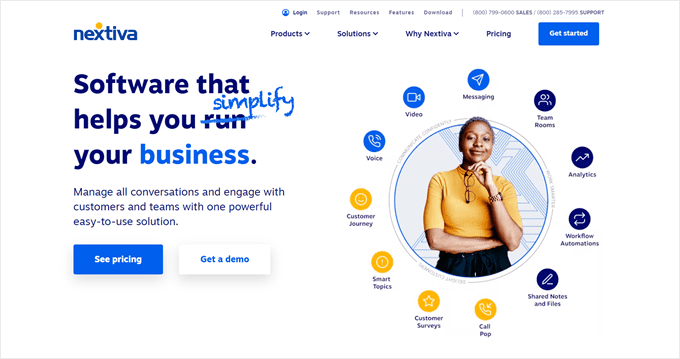
We’ve been using Nextiva at WPBeginner for years, and it’s hands-down the best virtual phone service we’ve tried. It’s all cloud-based, which is great for our remote team. We can answer calls from anywhere using their app on our computers or phones.
Nextiva isn’t just a phone system. In our experience, it’s a complete help desk. You can use it to talk to customers through phone, SMS, chat, video, and even social media. One feature we love is the screen pops, which give us detailed info about the caller to improve the calling experience.
The IVR (Interactive Voice Response) system is another game-changer. It handles simple routine tasks automatically, which means we can focus on the trickier customer issues. Plus, it integrates smoothly with our other tools like Salesforce and Microsoft.
One downside about Nextiva is its unlimited plan is only available for users in North America. So if you’re based elsewhere, you may need to find other solutions instead.
Pros of Nextiva:
- Cloud-based business phone service, perfect for remote work
- Affordable cell phone plans
- Handles multiple communication channels
- Lots of useful features like video calls and auto-attendant
- Easily connects with other business tools
Cons of Nextiva:
- Nextiva’s unlimited plan is only available in the US and Canada
Pricing: Nextiva starts at $30 per user per month for unlimited voice and video calling. To access call center features advanced IVR and intelligent routing, you’ll need the Power Suite plan, which costs $60 per user per month.
WPBeginner readers can use our special Nextiva coupon to save up to 44%.
Why we chose Nextiva: From our firsthand experience, Nextiva offers the best balance of features, ease of use, and affordability for a business phone system.
2. RingCentral
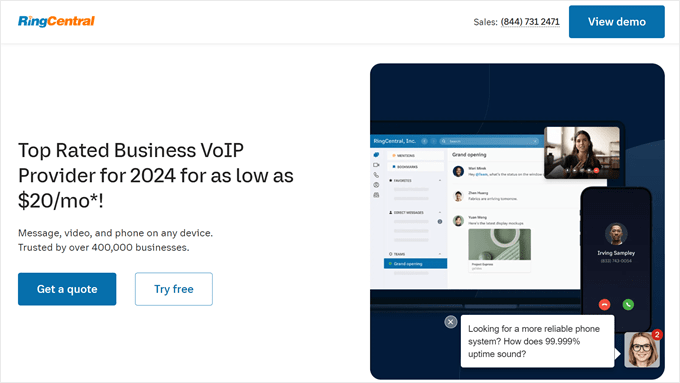
RingCentral is a popular business VoIP service provider that lets you set up a cloud call center solution for your business. In our trials, we were impressed by how quickly we could set up customer support from anywhere, at any time.
One thing that caught our attention was RingCentral’s gamification options. This can really boost agent productivity. We also appreciate the comprehensive workforce management tools that handle teams’ schedules and plan inbound calls based on traffic volumes.
The analytics RingCentral provides are top-notch. In our tests, we could track KPIs in real time and set up custom dashboards. The automated IVR system and predictive dialer were other features we found particularly useful.
Unfortunately, some important business features like internet faxing and storage for recording is only available after upgrading.
Pros of RingCentral:
- Cloud-based with omnichannel support
- Gamification options for agent productivity
- Robust workforce management tools
- Detailed real-time analytics and reporting
- Automated IVR and predictive dialer
Cons of RingCentral:
- Certain features like online fax can only be accessed after upgrading
Pricing: Starting at $20 per month per user when paid annually, which includes unlimited domestic calling.
Why we chose RingCentral: RingCentral offers versatile, industry-specific solutions that cater to a wide range of businesses, from eCommerce to finance.
3. Ooma

Ooma is a comprehensive virtual phone solution that caters to businesses of all sizes. We’ve seen it work well for both startups and larger enterprises, effectively keeping remote teams and customers connected.
Setting up a cloud call center with Ooma is straightforward. Its intelligent call routing helps reduce long call queues for your customer support, which is a significant advantage. The drag-and-drop call flow designer is intuitive, allowing for quick creation of custom call flows.
Ooma’s features include multi-level IVR and skills-based routing, which enhance its functionality. The intelligent reconnect feature is particularly useful, automatically connecting callers back to the agent they were speaking with if a call drops.
Pros of Ooma:
- Easy setup for cloud call centers
- Intelligent call routing to reduce queues
- Intuitive drag-and-drop call flow designer
- Multi-level IVR and skills-based routing
- Intelligent reconnect feature
Cons of Ooma:
- Doesn’t match the multiple reporting features and reports that Nextiva offers for measuring your VoIP call center efficiency
Pricing: Starts at $19.95 per month per user for unlimited calling in US, Canada, Mexico, and Puerto Rico.
Why we chose Ooma: Ooma provides a solid, feature-rich solution that’s particularly well-suited for small to medium-sized businesses looking to add a call center.
4. Freshdesk
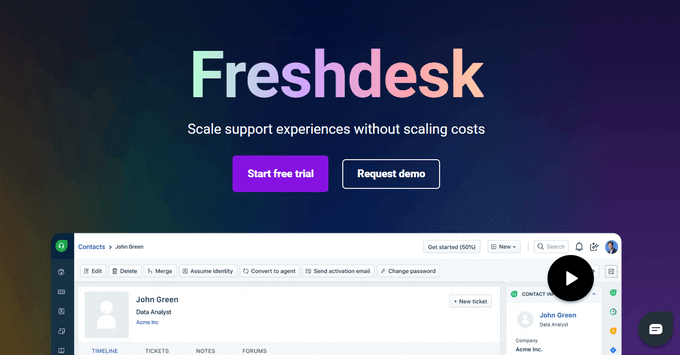
Freshdesk is a popular contact center solution used by many businesses. It’s easy to set up, often taking just a few clicks. We like its AI-powered voice responses, which help handle customer calls automatically.
Freshdesk works well for global businesses. You can use your own phone or buy numbers from over 50 countries. This makes it easy to talk to customers worldwide. The pricing is also flexible, growing with your business.
One thing we found helpful is how Freshdesk handles different types of customer contact. You can turn a call into a support ticket and manage all customer messages in one place. It also has useful tools like call recording and voice bots.
Despite how beginner-friendly it is, some users may find Freshdesk’s call center features lacking, especially compared to Nextiva.
Pros of Freshdesk:
- Quick and easy setup
- AI-powered voice responses
- Works well for global businesses
- Manages different types of customer contact in one place
- Useful features like call recording and voice bots
Cons of Freshdesk:
- Not the most advanced solution on the list
Pricing: Freshcaller starts at $15 per month per agent, which includes up to 2000 incoming minutes. After that, you have to pay $0.013 per minute. There’s also a free plan, but it doesn’t include any free minutes.
Why we chose Freshdesk: It’s easy for beginners to use, but may not have all the advanced features some businesses need in a call center.
5. LiveAgent
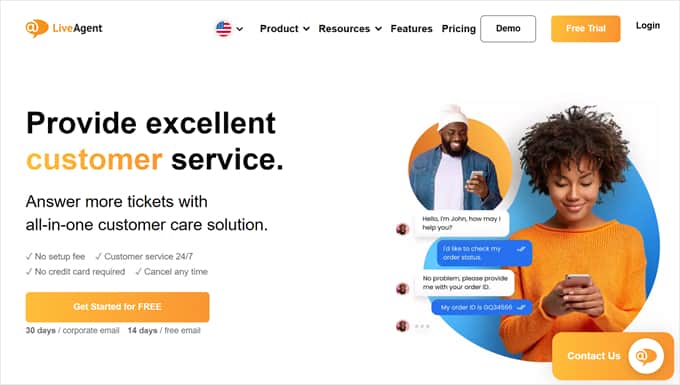
LiveAgent is a cloud-based call center solution that allows support agents to connect with customers from anywhere.
This software comes with a variety of features, including IVR, call-back requests, and unlimited call recording. The smart call routing and video conference calling tools add to its functionality. LiveAgent also includes chatbot capabilities and automatic call distribution.
One of LiveAgent’s strengths is its compatibility with other tools. It integrates well with popular CRMs like Salesforce and email marketing tools. We also like that it makes it easy for WordPress users to add a live chat button to their sites.
Pros of LiveAgent:
- 14-day free trial available
- Cloud-based system for remote work
- Comprehensive feature set including IVR and video calling
- Easy WordPress integration
Cons of LiveAgent:
- The call center features are only available in the second lowest-tier plan and above, but not in the cheapest one.
Pricing: Starting at $15 per agent per month when billed annually, but the call center support is only available in the Medium plan which costs $29 per agent per month.
Why we chose LiveAgent: It’s a solid option for those who want to add a call center and a live chat functionality to their WordPress website.
6. 8×8

8×8 is a cloud-based platform that provides a secure call center solution. It boasts a 99.99% uptime, which means it’s very reliable and performs quickly without much downtime. This can be crucial for businesses that need constant communication.
What we liked about 8×8 is the platform has an easy-to-use interface and offers lots of resources to help you get started. These include a detailed knowledge base and expert connections.
8×8 also comes with many useful features like easy call routing, click-to-call options, and text analytics. You can also use it to run customer surveys and improve your support through analytics.
Pros of 8×8:
- Very reliable with 99.99% uptime
- User-friendly interface with helpful resources
- Comprehensive feature set including call analytics
- Supports customer surveys and feedback collection
Cons of 8×8:
- Fewer features compared to some competitors like Nextiva and RingCentral
- Pay-per-use pricing can add up quickly for high-volume users
Pricing: 8×8 doesn’t display pricing online, you need to contact sales for a quote.
Why we chose 8×8: It’s a robust solution that’s particularly suitable for larger organizations and SaaS enterprises needing a powerful, scalable call center platform.
7. CloudTalk
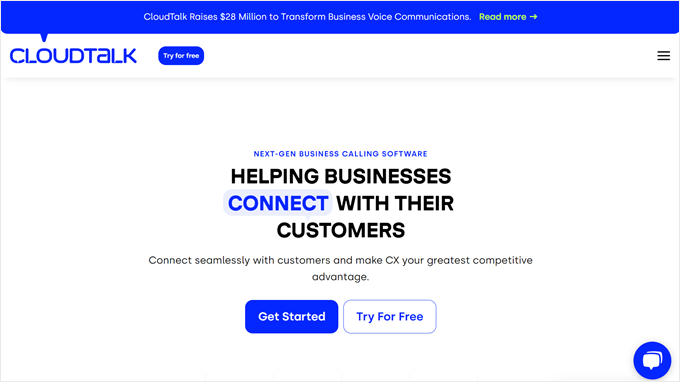
CloudTalk is a popular virtual call center platform used by big companies like DHL and Mercedes Benz. It offers national phone numbers for your business, including toll-free options.
The software comes with basic tools like call queuing and recording, as well as more advanced options like smart outbound autodialer and 3-way calling. In our experience, the fax-to-email and call masking features are particularly useful for businesses needing extra flexibility.
One area where CloudTalk stands out is its intelligent routing. The call flow designer lets you create automated workflows easily. We’ve also found the skill-based routing and VIP queues helpful for managing different types of calls efficiently.
Pros of CloudTalk:
- Offers clear calls through global partnerships
- Wide range of features from basic to advanced
- Strong intelligent routing capabilities
- Flexible with national and toll-free numbers
Cons of CloudTalk:
- Certain features are only available through upgrading, like business hours and personalized greetings.
Pricing: Starting at $19 per month per user for unlimited inbound and intracompany calls.
Why we chose CloudTalk: CloudTalk is a dedicated call center software. You can use it to provide inbound support, make outbound calls, and easily collaborate with internal teams.
Which Is the Best Call Center Software?
If you’re looking for a complete cloud-based call center, then we highly recommend Nextiva. The software ticks all the boxes for what you should look for in a call center solution.
It offers powerful features to help you create the ultimate call center operations. Nextiva is a complete virtual phone solution for businesses that want to take their customer support to the next level.
You get IVR, call recording, video conferencing, mobile and desktop apps, detailed reports and metrics to track performance, and so much more with Nextiva. Plus, it easily integrates with different CRMs and marketing tools.
Call Center Software FAQs
At WPBeginner, we’ve helped thousands of small business owners find the right call center software for their needs. Based on our experience, here are some of the answers to the most frequently asked questions about call center software:
How do I set up call center software?
Many of the call center solutions on this list are super simple to set up. For example, with call center software like Nextiva, you can log into the admin dashboard to set business hours, configure team extensions, set up voicemail, design call flows, and more, all in one place.
Then, you can simply install the Nextiva app on any mobile device or desktop to start making and receiving calls.
How do I automate my call center?
You can easily automate your call center with any of the call center software we’ve mentioned in this list. They each come with their own built-in automation features to help you increase efficiency and lower costs.
Some of these automation features include interactive voice response (IVR), auto-attendants, voicemail transcription, auto dialing, intelligent call routing, and more.
Which type of call center is best?
Both inbound and outbound call centers can be beneficial for business, but which is best depends on your specific needs.
Inbound call centers mainly receive calls from customers or potential customers. These calls are used to answer questions and solve customers’ problems, which improves customer service.
On the other hand, outbound call centers typically make calls to leads and prospects to promote the company and increase sales.
If you want to cover both sales and customer support, you can create a blended call center, which is a combination of both options.
We hope this article helped you find the best call center software. You may also want to read our guide on how to hire virtual assistants for your WordPress site and see our picks of the best customer service tools.
If you liked this article, then please subscribe to our YouTube Channel for WordPress video tutorials. You can also find us on Twitter and Facebook.
Disclaimer: We could have included other call center software in this list, like Dialpad, Talkdesk, Twilio, Five9, and others. But we decided only to include the very best call center software options to help you avoid choice paralysis.





Have a question or suggestion? Please leave a comment to start the discussion.